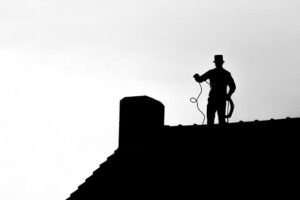
Chimney leaks are almost always signs of damage that can eventually lead to bigger problems.
“Pumpkin Spice” is already popping up in certain stores and restaurants, heralding the return of fall. For those who love it, the fall is a magical season. For everyone else, at least there is the literal and figurative comfort of warm, welcoming fireplaces on cool evenings and cold nights. If the strong, durable masonry component of your home that makes crackling winter fires possible currently has signs of a leak, now is the best time to address it. Chimney leaks are almost always signs of some sort of damage that can eventually lead to bigger and more dangerous problems if you don’t have a professional out for a chimney repair. You should have a chimney sweep come out at least once a year to check for a chimney inspection, to check for signs of problems, fix them, and do some cleaning, but in the meantime, let’s review some of the most common sources of chimney leaks.
Chimney Cap
The chimney cap is the first stop when checking for a leak. Over time, they can crack, corrode, and/or rust. They are exposed to consistent and persistent weathering all year long and are not intended to last forever. They will eventually need to be replaced. If you catch the damage to the cap early, you limit how much additional damage happens to the rest of the chimney.
Chimney Flashing
Flashing is the sheet metal that covers the joining between the roof and the chimney (if the chimney comes up through the roof). When undamaged and installed correctly, it forms a seal that keeps out water. If water is getting in anyway, there is an issue with it that needs to be professionally addressed.
Damper
The damper stops air from escaping when you’re not using the chimney by forming an airtight seal. It also prevents water from getting in and causing damage. If you’re noticing leaks, an ill-fitting damper might be the problem. Have a professional come out and check that the damper in undamaged and that creosote hasn’t built up and caused it to not shut completely.
Masonry Damage
Finally, the biggest potential issue on this list is that the actual masonry could be damaged. Once cracks start forming, water that gets in, especially in the winter when it will freeze and expand, will continue to chip away and cause even more damage. If you see cracks, it is important to have a professional come out and repair it as soon as you can.
Call the Experts at Champion Chimneys for a Chimney Inspection Today!
Champion Chimneys, Inc. is a fully licensed, bonded, and insured chimney service company that has served customers in Baltimore County, Howard County, and Anne Arundel County, Maryland, since 2001. Our team is trained and certified by Certified Chimney Professionals, Inc. (CCP, Inc.). Courteous service is our trademark, and our crews arrive on time in uniform, driving fully equipped trucks. We specialize in all aspects of your chimney system. Whether you need chimney and flue cleaning service or a full chimney rebuild or inspection, contact us at 443-Chimney today and let us fix all your chimney problems. Also, follow us on Facebook, Twitter, LinkedIn, and Pinterest.
